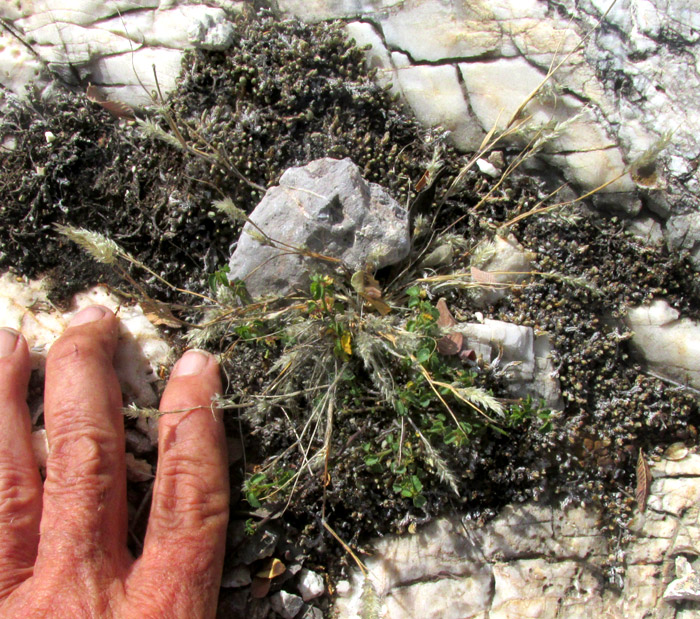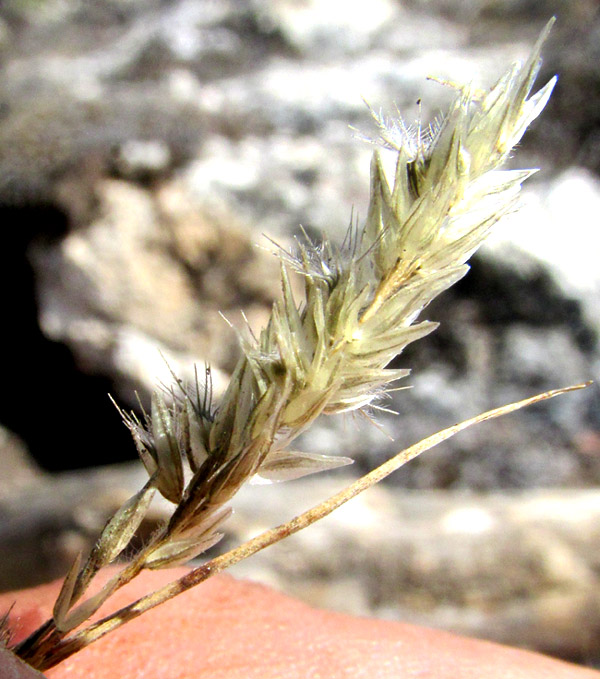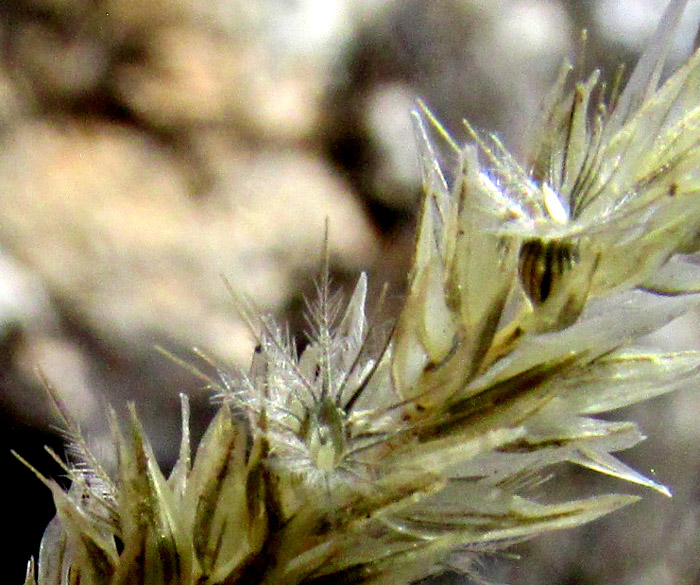Excerpts from Jim Conrad's
Naturalist Newsletter
Entry dated March 9, 2024, from notes taken about 2kms west of Higuerillas, Municipality of Cadereyta de Montes; N20.9086°, W99.7865°, elevation ~1760 meters (~5760 feet); on greywacke sandstone cap of hill; area constituting a narrow belt of the extreme southern extension of the Chihuahuan Desert, Meridional Subregion; central Querétaro state, MÉXICO
NINEAWN PAPPUSGRASS

Atop the windswept, sunbaked hill, the above small grass's dried-up and dead stems and leaves still bore seed-bearing heads. The grass's branches grew close to the ground, a good strategy in this area with many roving feral burros. The grass occupied a patch of moss carpeting a depression in an outcrop of white, crystalline sedimentary rocks known as evaporites; evaporites are formed during the geologically ancient evaporation of water bearing dissolved mineral salts such as sodium and calcium. Judging from the above rock fragments' cleavage planes, this particular evaporite tends toward calcareous calcite.

The flowering head, at least toward the bottom, is branched, so it's a panicle type inflorescence, albeit one with its few short branches held so close to the rachis that the panicle looks like a spike. Flowering took place earlier and already most of the one-seeded, caryopsis-type fruits have been dispersed. The few remaining caryopses appear to be equipped with feathery trichomes, which will serve as parachutes during the fruits' wind dissemination. Once the caryopses are disseminated, white, scale-like glumes remain in the flowering head, probably encouraging the entire head to shake in the wind, dislodging remaining caryopses.

Up close, something remarkable is seen. Above, especially in the upper, right corner, it appears that the caryopses bear feathery bristles, or awns, as with many one-seed cypselae of members of the Aster Family, such as the Dandelion and various thistles. In the Aster Family, such parachute-like appendages are called pappuses, but grasses don't have pappuses.
Later I was to learn that the feathery awns do not arise atop the caryopses, but rather from the papery, scale-like lemmas, which are similar in texture to the glumes, and arise immediately below each caryopsis, and partially envelops it. For me, such lemmas bearing feathery awns was a whole new Grass Family concept.
The above features led me to a small "tribe" of the Grass Family, the Pappophoreae, of which I'd never heard. It comprises only five genera containing around 40 species -- of ~12,000 occurring worldwide -- overwhelmingly limited to tropical and subtropical environments. In the Americas, the only genus in the Family producing feathery awns looking like Aster Family pappuses, is Enneapogon, whose species often are known as pappusgrasses. Pappusgrasses occur mainly is African and Australia, but as Enneapogon currently is configured, only two of its species appear in the Americas. Of those two species, the only one whose panicles are so tightly contracted that they look like spikes, is ENNEAPOGON DESVAUXII, usually known in English as Nineawn Pappusgrass.
Nineawn Pappusgrass is thought to be native to the southwestern US and most of upland Mexico, as well as parts of western South America, the dryer regions of Africa and Asia, and it turns up here and there elsewhere. That's a peculiar native distribution, causing one to wonder how it happened, and whether the definition of the species needs more study. In upland central Mexico it's described as occurring in arid scrub and grazed grasslands.
Holly Ganz and others in the 2014 study entitled "Interactions between Bacillus anthracis and Plants May Promote Anthrax Transmission," described Nineawn Pappusgrass as a pioneer species tolerating overgrazing, and occurring in dry, calcareous soils. They noticed that after an anthrax outbreak in Namibia, southwestern Africa, Nineawn Pappusgrass formed patches of robust growth wherever individual Zebras had died the previous year.
Furthermore, they reasoned that the anthrax bacterium "... B. anthracis may promote plant growth as a way of attracting hosts to graze on infectious material at carcass sites." The bacterium kills an animal, the dead animal encourages the growth of Nineawn Pappusgrass, animals eat the grass, get sick and die, and the cycle repeats.
Here in Mexico, the 2024 study by Alan Ávarez-Holguín and others entitled "Grass species with potential for rangelands restoration in northern Mexico: an assessment with environmental niche modeling," found that Nineawn Pappusgrass was one of nine grass species most suitable for revegetating destroyed shrublands, of which Mexico has plenty.
Our top picture of a dead-looking grass may show one of Nineawn Pappusgrass's prime adaptations: It's a perennial with branches arising from a hard, knotty base. When the rains end, branches die back, but the base remains to sprout again.